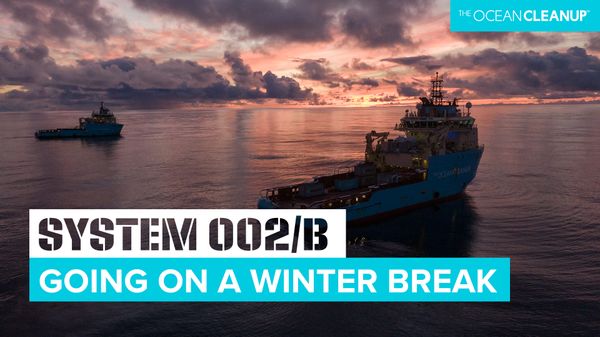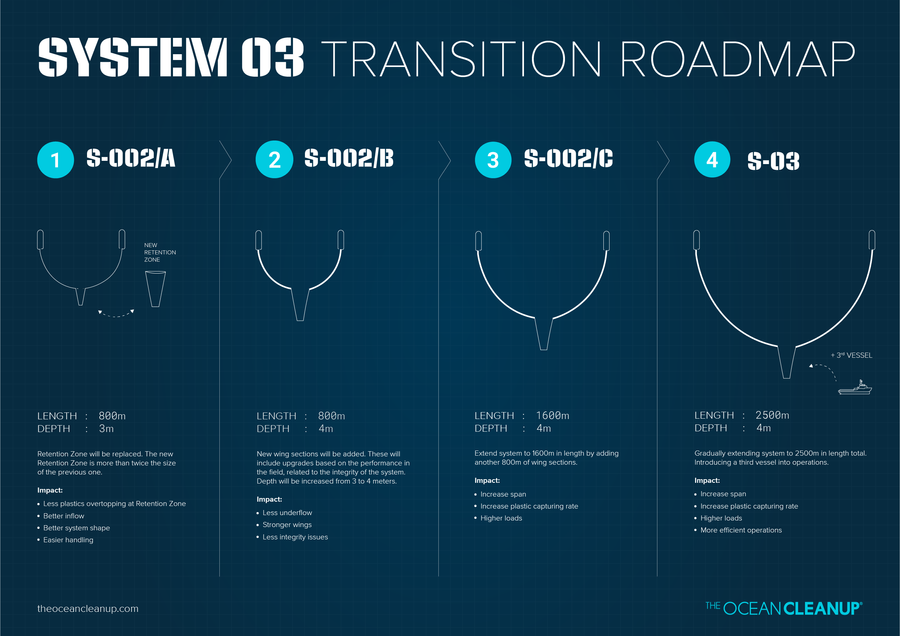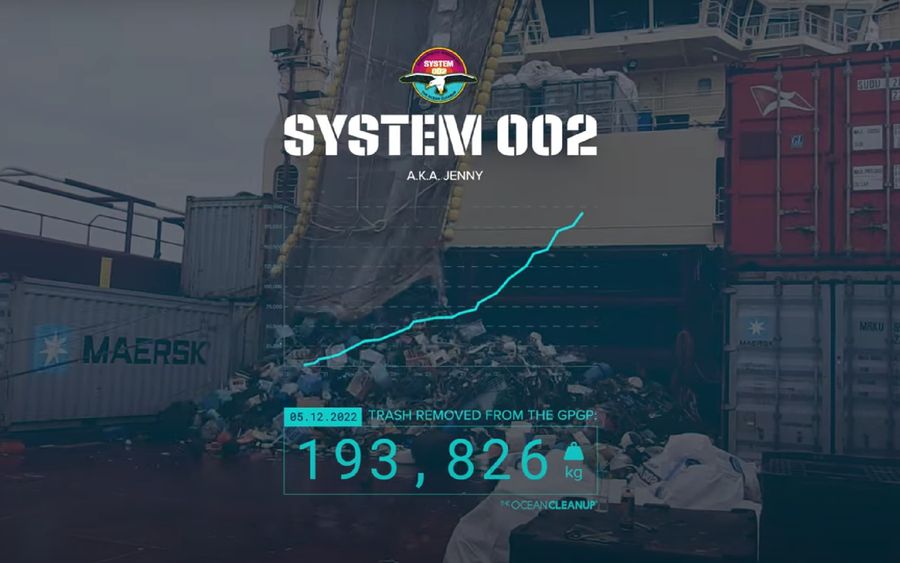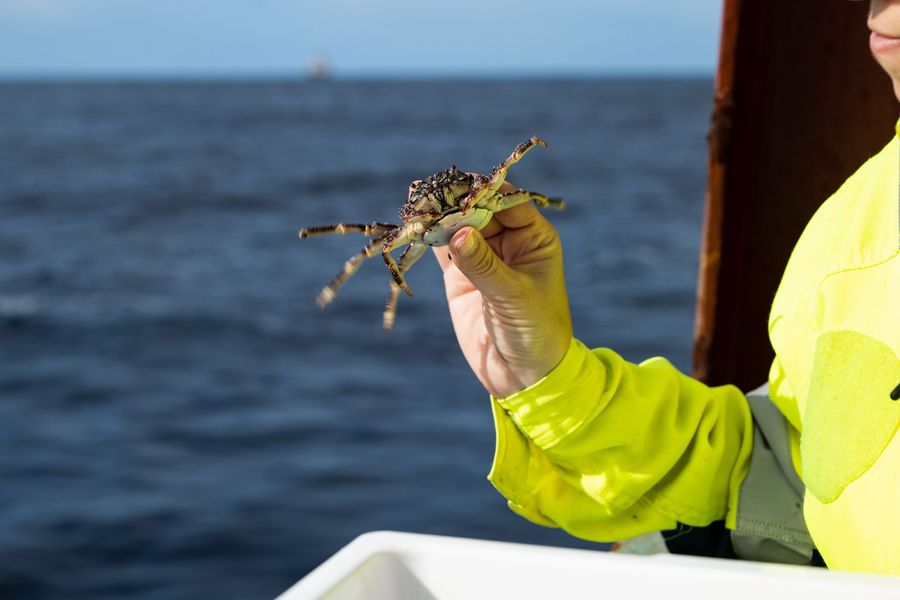
System 002 Signs Off for 2022 – Redeployment in Spring 2023
Back to updatesThe Ocean Cleanup develops and scales technologies to rid the oceans of plastic. Tackling such an ambitious challenge requires acting where we can have the greatest impact on plastic pollution. In the oceans, this means focusing on the largest accumulation of floating plastic anywhere on Earth – the Great Pacific Garbage Patch in the North Pacific Ocean.
As we enter winter, it is time to bring our system back to port for scheduled evaluation and upgrades as part of the ongoing transition to the larger and more efficient System 03. We are scheduled to head back out to restart cleaning the GPGP in March 2023.

SYSTEM 002 IN 2022
After demonstrating Proof of Technology the previous year, 2022 was all about cleaning. It was a successful year for The Ocean Cleanup in the GPGP:
System 002: 2022 in numbers
- 8 trips into the GPGP on cleaning operations
- Over 150 days at sea (including transit)
- 153,000 kg of plastic removed from the GPGP in 2022
- 4 consecutive trips with catch totals over 25,000 kg
- 99.9% of catch comprising only plastic
We captured our first plastic from the GPGP in 2019 with System 001/B, and since then we’ve been refining our steering strategy and deepening our understanding of plastic behavior in the oceans. In 2021 we introduced System 002, and having now demonstrated that our system can consistently harvest significant amounts of plastic, we’re currently in transition to System 03 – our largest and most efficient cleanup system so far.
We are now at the mid-way point in this transition. In summer 2022 we installed a new Retention Zone (more than twice the size of the previous one) to create System 002/A. Next, we added new wing sections with increased durability, and increased wing depth from three to four meters, reducing the amount of plastic lost due to underflow. We call the current iteration System 002/B.
In 2023 we will extend the wings to 1600 meters to produce System 002/C, before conducting further tests. We will then further expand the wings to their full size of 2500 meters. At that point, the transition will be complete, and System 03 will begin operations. We are already seeing the impact of our strategy learnings and the transition to System 03: our final four trips of the year saw our four largest catches, including our current record of 30,980 kg on a single trip. An unexpected potential issue is capturing too much plastic per trip, and not having sufficient space on board to process it all. For this reason we are exploring the option of having a compressor on board once System 03 is deployed.
The continuity of cleaning operations during this transition was essential in demonstrating that we are moving towards our efficiency targets and progressing our plan for scale-up. Significant milestones such as the extraction that brought us over the 100,000 kg barrier in the GPGP are documented and shared with our growing community of supporters worldwide, aiding the visibility of our mission and highlighting the urgency of the plastic pollution problem.
View this post on Instagram
Boyan Slat, founder and CEO on the 100,000 kg milestone reached
System 002 has continued to perform strongly in the Pacific Ocean during 2022, and the initial signs from the transition to System 03 are hugely positive. Which raises the question: if everything is going so well, why take a winter break at all?
HARSHER WEATHER, LOWER EFFICIENCY
As well as providing an opportunity for evaluation and offshore optimization of System 002, weather conditions over the winter months in the GPGP make this a timely opportunity for a pause.
Winter in the Pacific Ocean is harsh, with strong waves and dangerous storms that increase sailing times and reduce the amount of plastic we can catch, making our operation less efficient. Stronger winds cause larger waves, meaning more plastic is lifted over (or pushed under) the wings of our system. Harsh weather also limits implementation of our plastic hotspot computational modeling; even if we can identify an area of high density plastic, our vessels may not be able to move the system towards it if there is a severe storm nearby.
Our research and data gathering operations are also affected by the rougher seas; tagged plastic is more difficult to accurately track, and plastic behavior becomes harder to predict using our modeling. This means data gathered during these periods can be less reliable. Operations such as our Ground Truth research expedition (where we tested various monitoring methods to see how closely our modeling reflects real-life plastic behavior) would be much more challenging in winter conditions.
During the time System 002 is offshore, we will be continuing to make modifications and test the efficiency of the all-new components we are implementing, such as new larger floating fenders, specifically chosen to address the issue of overtopping we identified earlier this year; another measure to increase capture efficiency and reduce our cost and carbon output per kilogram of plastic removed.
We will also be continuing to study the data gathered during operations to refine our strategy to ensure the positive trends for 2022 are continued. We are deepening our research in plastic monitoring using both traditional methods involving tagged plastic and innovative AI object recognition technology – all designed to ensure we understand how plastic behaves in the ocean, and can most effectively aim our cleanup operations towards it. We will also be researching and implementing new protection and mitigation measures to safeguard marine life during this time. The winter break provides the best opportunity to take stock of our operations in 2022 and evaluate how to improve both strategically and technologically in 2023.
PRIORITIZING THE MARINE ENVIRONMENT
We are committed to maximizing our net positive impact on the marine environment. In that light, we place particular importance on one particular figure from our 2022 data: 99.9%. This is the amount of our total catch that consists of plastic, leaving a level of bycatch of 0.1%. While this is not perfect and we are working hard to reduce it further, we believe this data shows that our mitigation measures and animal protection procedures are working effectively so far. We have also seen a reduction in bycatch rates during the year (see our January 2022 mid-term evaluation) as we implement new learnings and modifications.
Our environmental performance is a result of the measures we have taken since we began our ocean operations. Our systems move very slowly, meaning fish and marine animals can easily swim away, and our crew always has the option of triggering the emergency release to free any animal which has become trapped in the Retention Zone; although this results in the loss of any plastic which has been captured, we keep this option available for any serious encounters.
Upgrades to be implemented during the transition to System 03 include more underwater cameras to allow us to more closely monitor encounters with marine life, and increasing the number of openings throughout the system to allow animals to swim out. We will also be trialing various new deterrent and mitigation measures during 2023, working with our in-house and third-party marine biologists to ensure that we continue to reduce any type of bycatch to the minimal level possible.
During this winter break, we will be reviewing and improving these mitigation measures and procedures. Maximizing our net positive impact on the marine environment and the wildlife that inhabits it will continue to be our top priority when we return to cleaning operations in 2023.
COUNTING DOWN TO SPRING
System 002/B returned to port in Victoria, Canada on 13 December 2022 to begin its idle phase for the winter. The Ocean Cleanup has made real progress in the GPGP this year, demonstrating impact and scalability that shows ridding the oceans of plastic is a realistic objective. Our crew will be working hard during the winter to optimize System 002 and prepare us for a return to the open ocean in March 2023.





